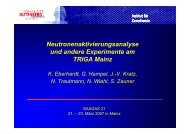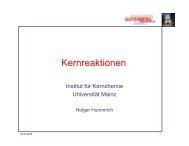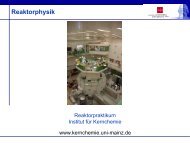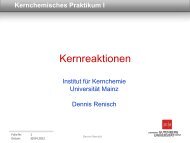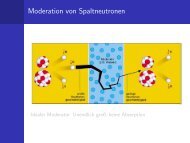jahresbericht 2007 - Institut für Kernchemie - Johannes Gutenberg ...
jahresbericht 2007 - Institut für Kernchemie - Johannes Gutenberg ...
jahresbericht 2007 - Institut für Kernchemie - Johannes Gutenberg ...
Create successful ePaper yourself
Turn your PDF publications into a flip-book with our unique Google optimized e-Paper software.
Syntheses of WAY 100635 derivatives as 5-HT 1A antagonists<br />
Matthias Herth, Markus Piel, Frank Rösch<br />
<strong>Institut</strong>e of Nuclear Chemistry, <strong>Johannes</strong> <strong>Gutenberg</strong>-University Mainz, Mainz, Germany<br />
Introduction: Depression is a mood disorder, which<br />
affects an estimated 121 million people worldwide. In<br />
the U.S. alone, depression has a monetary impact in the<br />
tens of billions of dollars per year in medical costs and<br />
lost productivity, and an immeasurable toll on quality of<br />
life. The molecular basis for depression is not fully<br />
understood; however, deficits in the activity of<br />
serotonin-mediated neurons in the brain are clearly<br />
central to the disease. In particular, the 5-HT 1A receptor,<br />
found in high concentration in the limbic system, where<br />
it is thought to play a role in emotional processes, is a<br />
major target for neurobiological research and drug<br />
development. Its activation leads to a number of<br />
physiological changes.<br />
New arylpiperazine derivatives were prepared by<br />
Fiorino et al 2005 2 to identify highly selective and<br />
potent ligands for the 5-hydroxytryptamine 1A (5-<br />
HT1A) receptor as potential pharmacological tools in<br />
studies of central nervous system (CNS) disorders.<br />
Therein, 4-[3-[4-(o-methoxyphenyl) piperazin-1-<br />
yl]propoxy]-4-aza-tricyclo-[5.2.1.02,6] dec-8-ene-3,5-<br />
dione showed the highest selectivity and a K i of 0.021<br />
nM.<br />
Aim: The aim of this study was to develop new 5-<br />
HT 1A agents with high affinity and selectivity over other<br />
serotoninergic, dopaminergic, and adrenergic receptors<br />
with the possibility to label them with flourine-18.<br />
Arylpiperazines similar to those published by Fiorino et<br />
al. 2 were chosen as a starting point. Substituting a<br />
methoxy- by a fluoro-ethoxygroup should be<br />
appropriate for introducing a fluorine.<br />
Experimental/Discussion: We have analyzed a<br />
set of arylpiperazine-N-alkyl derivatives with a novel<br />
exo-N-oxy-5-norbornene-2,3-dicarboximide fragment as<br />
the terminal part of the long-chain arylpiperazines, which<br />
contains an oxygen atom in the spacer (Fig 1).<br />
O<br />
The general strategy for the synthesis of the target<br />
compounds is summarized in fig. 2. The general procedure<br />
is as follows: alkylation of the heterocycle endo-Nhydroxy-5-norbornene-2,3-dicarboximide<br />
with 1-bromo-2-<br />
chloroethane or 1-bromo- 3-chloro-propane in the presence<br />
of NaOH in absolute ethanol gave the corresponding<br />
chloro-alkyl norbornene derivatives 1. Subsequent<br />
condensation of compounds 1 with the desired 4-Xsubstituted<br />
piperazines, performed in CH 3 CN in the<br />
presence of K 2 CO 3 and NaI under reflux, provided the<br />
final compounds, respectively.<br />
O<br />
O<br />
O<br />
O<br />
N<br />
N<br />
OH<br />
O<br />
i<br />
(CH 2 ) 3<br />
N N X<br />
O<br />
O<br />
N<br />
O<br />
Cl<br />
(CH 2 ) 3<br />
Fig 2: Reagents and conditions: (i) Br(CH 2) 3Cl, NaOH,<br />
absolute EtOH, 70 °C, 24 h; (ii) 4-X-substituted<br />
piperazine, K 2CO 3, NaI, CH 3CN, reflux, 24 h<br />
Conclusion: To verify the potential of those new<br />
WAY 100635 arylpiperazine derivatives in vitro<br />
experiments are planed.<br />
References:<br />
1 World Health Organization WHO Fact Sheet Number<br />
265; The World Health Organization: Geneva,<br />
Switzerland, 2001<br />
2 Fiorino et al.; J. Med. Chem. 2005, 48, 5495-5503<br />
ii<br />
N<br />
O<br />
(CH 2 ) 3<br />
N N X<br />
O<br />
X =<br />
O F F O<br />
O<br />
F<br />
Fig.1:<br />
General structures<br />
- B4 -



